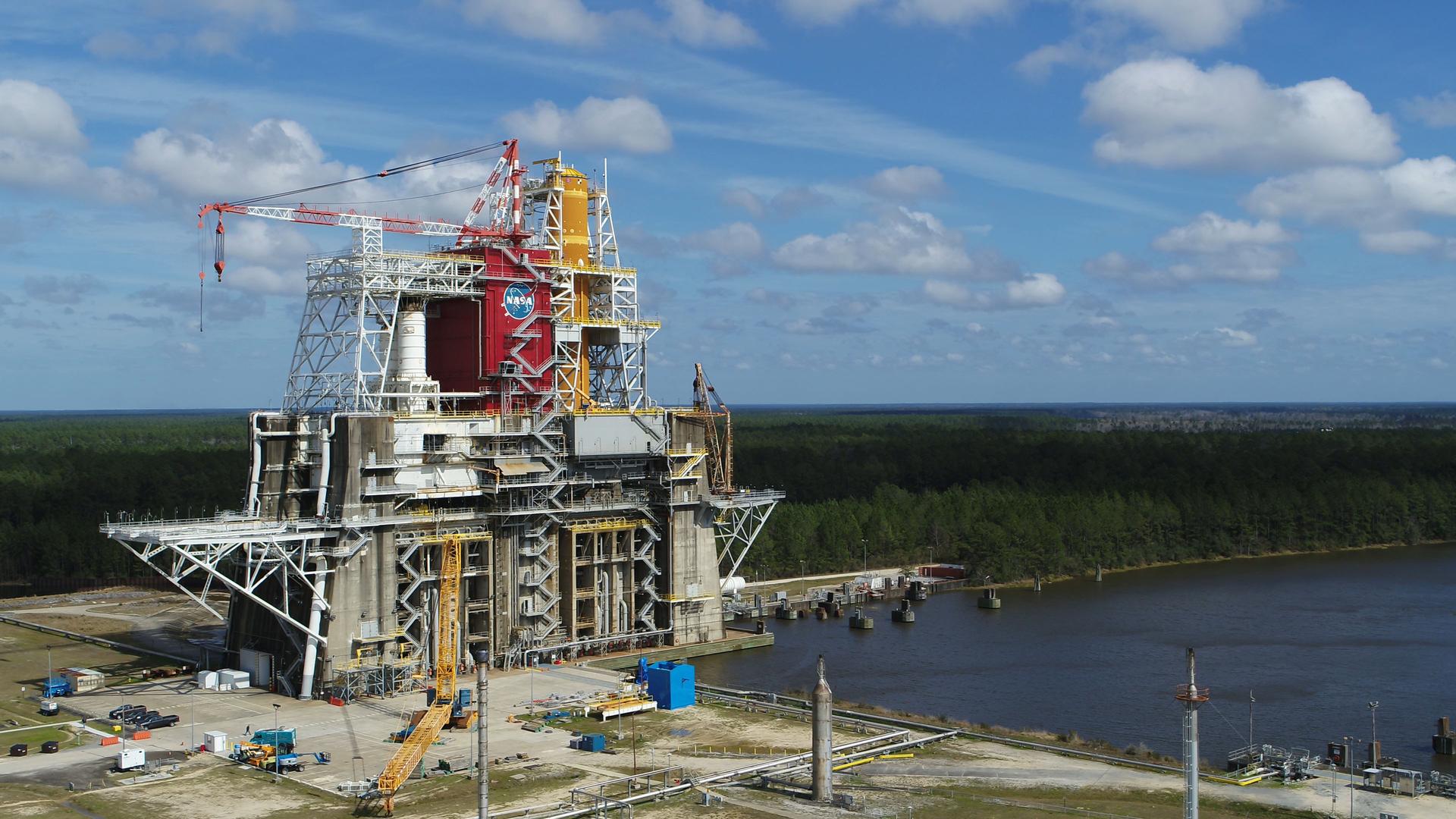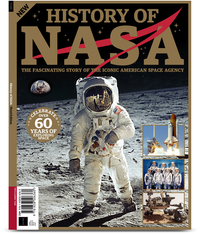NASA and Boeing will attempt 2nd hot fire test of SLS megarocket Feb. 25

NASA and Boeing are ready to light up the core stage of the massive Space Launch System (SLS) rocket in a second hot fire test, currently scheduled for Thursday (Feb. 25).
The critical engine test is the last installment of an eight-part, year-long green run test meant to ensure that the massive rocket will work properly on its first launch, which will send the uncrewed Artemis 1 mission around the moon. A first attempt at the hot fire test, which occurred on Jan. 16, ended early when the engines shut off after firing for about 67 seconds. The test had been targeting an eight-minute fire to simulate the work the rocket will do during launch.
"Our core-stage green run is the most comprehensive test that we're undertaking to make sure that SLS can safely launch the Artemis missions to the moon," John Honeycutt, SLS program manager at NASA's Marshall Space Flight Center (MSFC) in Alabama, said during a virtual news conference today (Feb. 19). "This is a generational opportunity to learn as much as we can about the rocket while we've got it in this test configuration, before we get to flight."
Video: How NASA's SLS megarocket engine test works
History of NASA: $22.99 at Magazines Direct
Discover the story of how and why NASA was created, its greatest triumphs, darkest days, and of the times it exceeded all possible hopes. A tale of adventure, heroism and resourcefulness, learn of the space agency's greatest achievements and how — over six decades — the organization has consistently and tirelessly devoted itself to its founding principle: that "activities in space should be devoted to peaceful purposes for the benefit of all humankind".
The second green run attempt will begin early in the morning of Feb. 25 at NASA's Stennis Space Center in Mississippi, with test personnel deciding whether to fuel the rocket stage at 7 a.m. EST (1200 GMT). The hot fire itself is currently scheduled for 5 p.m. EST (2300 GMT), but test leaders said that could be moved about an hour earlier given the team's experience on the first green run.
Although the green run team is targeting an eight-minute fire, there's a chance the engines won't burn for that long, test personnel emphasized during the news conference. The test must last a little over four minutes to produce the data the team needs to meet remaining objectives in the vehicle's verification program, Julie Bassler, SLS stages manager at MSFC, said during the news conference.
From there, it's a matter of seeing how things go. Running for the full eight minutes to burn all the fuel is safest for the ground team, Bassler said, but the test is very stressful and the team will cut it short if the hot fire has produced enough data and looks to be threatening the core stage itself.
Get the Space.com Newsletter
Breaking space news, the latest updates on rocket launches, skywatching events and more!
"We want to get through the count again, we want to get ignition again, and then just run as long as we can, but while protecting the vehicle," John Shannon, vice president and SLS program manager at Boeing, said. Prior to the Jan. 16 test, Shannon said the team had hoped for a duration of at least 250 seconds for the hot fire.
The upcoming test comes as Mississippi and much of the South are taking stock after a serious winter storm over the weekend left the region facing frozen pipes and power outages. "The team has done a really great job and very inventive in figuring out how to set up environments around the areas where they're working on to keep the temperatures we need," Bassler said. "We have a really good system already in place that does help us there."
The worst seems to have passed and through the hot fire itself, conditions appear to be easing up, said Ryan McKibben, green run test conductor at Stennis.
"I wish we would have taken a picture though, there were some icicles coming from some of the rocket engines," he added. "Tonight should be the last night we have freezing temperatures and after that, we're actually looking at some pretty good weather coming up, knock on wood, for the next week."
The green run tests are indicative of the struggles that NASA has faced getting the over-budget and behind-schedule SLS off the ground. NASA leaders considered fast-tracking the vehicle's first launch but decided in July 2019 to conduct the green run tests as a safety measure. At the time, skipping the tests may have allowed the vehicle to meet its then scheduled flight date, in mid-2020.
Instead, in January 2020 the first SLS core stage headed to Stennis for the green run tests, targeting a new launch date of mid-2021. But just as engineers were preparing for the first test, applying launch-like forces to the suspended core stage, the coronavirus pandemic began speeding across the country. The COVID-19 virus was in Stennis' neighborhood by mid-March, and NASA shut down on-site access for all except the most critical work on March 20.
By the summer, tests were back on with COVID-19 precautions in place, and by August the team had completed the first four green run items. Meanwhile, Stennis was fighting a new challenge as a busy hurricane season battered the Mississippi coast, with six different tropical storms interfering with on-site work.
Then, the seventh test, a "wet dress rehearsal" simulating the countdown to launch ended up needing two takes, pushing the hot fire test to January. After evaluating the data from the Jan. 16 test, NASA officials decided to redo this test as well in order to get more complete data about the performance of the core stage.
If next week's test is satisfactory, personnel at Stennis will have 30 days to clean up the rocket part and prepare it for the journey to Kennedy Space Center (KSC) in Florida by barge. Meanwhile, the rest of the components of the Artemis 1 mission are at KSC already, with integration underway. Once the core stage arrives, that work will lead into a few tests before launch.
The launch itself could happen as early as October, although that's unlikely, Tom Whitmeyer, NASA's deputy associate administrator for exploration systems development, said during the news conference. "We'll see how we do against that October date. We certainly think we have an opportunity to fly this year," he said. "We do understand that these are first-time operations and weather can be a factor as well."
Once the hot fire is complete and the full Artemis 1 rig is in Florida, NASA will keep offering updates about the targeted launch date, he promised.
"I want to be perfectly clear, we will see a date that's later than that, and it's really hard to predict exactly what the date will be." Whitmeyer said. "We always take it a step at a time."
Email Meghan Bartels at mbartels@space.com or follow her on Twitter @meghanbartels. Follow us on Twitter @Spacedotcom and on Facebook.
Join our Space Forums to keep talking space on the latest missions, night sky and more! And if you have a news tip, correction or comment, let us know at: community@space.com.

Meghan is a senior writer at Space.com and has more than five years' experience as a science journalist based in New York City. She joined Space.com in July 2018, with previous writing published in outlets including Newsweek and Audubon. Meghan earned an MA in science journalism from New York University and a BA in classics from Georgetown University, and in her free time she enjoys reading and visiting museums. Follow her on Twitter at @meghanbartels.










